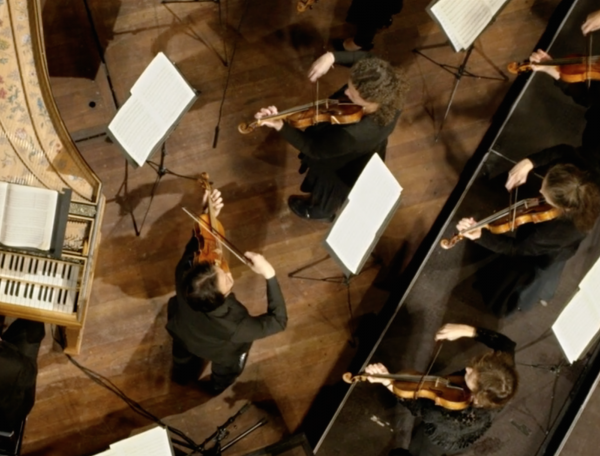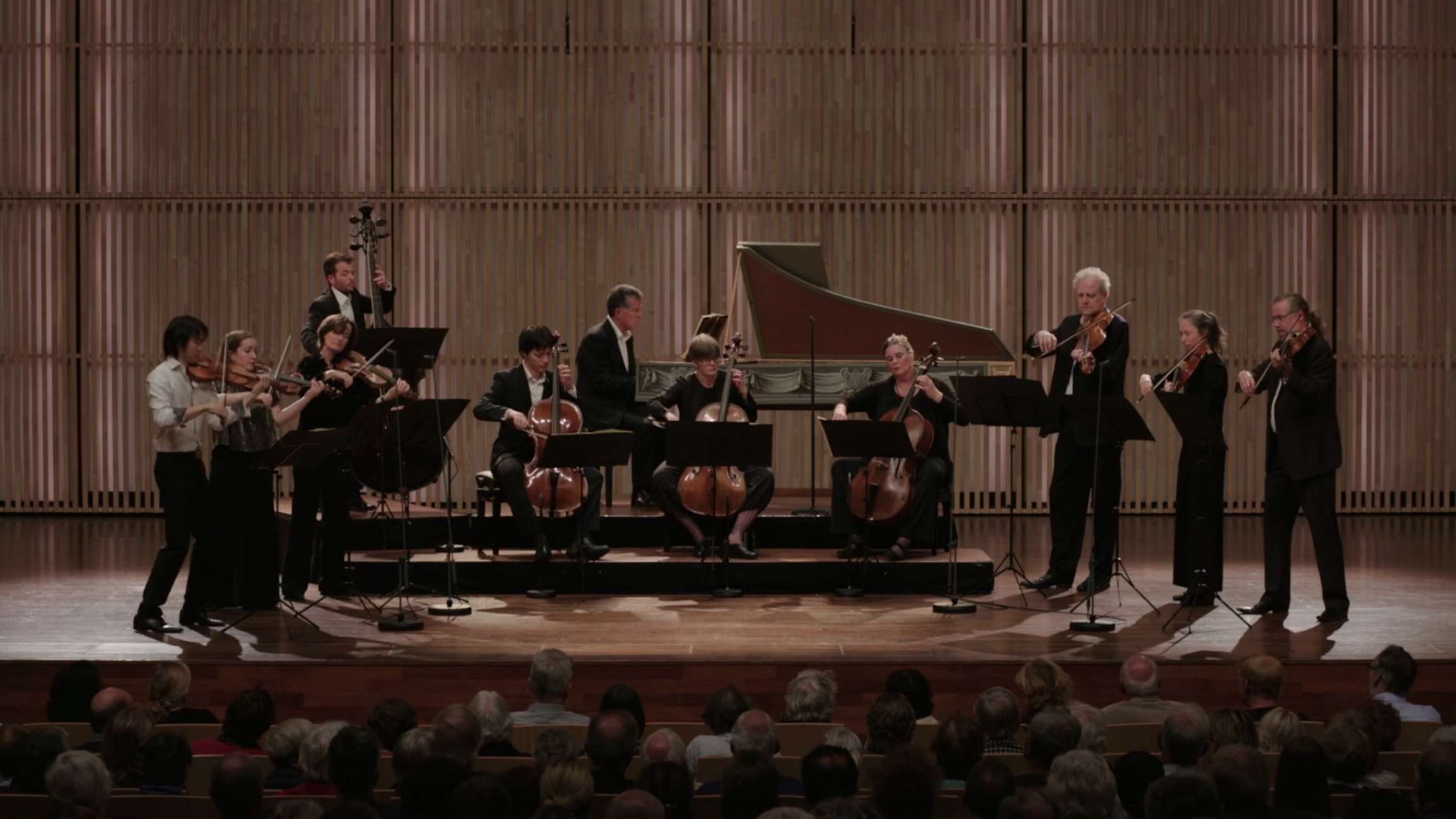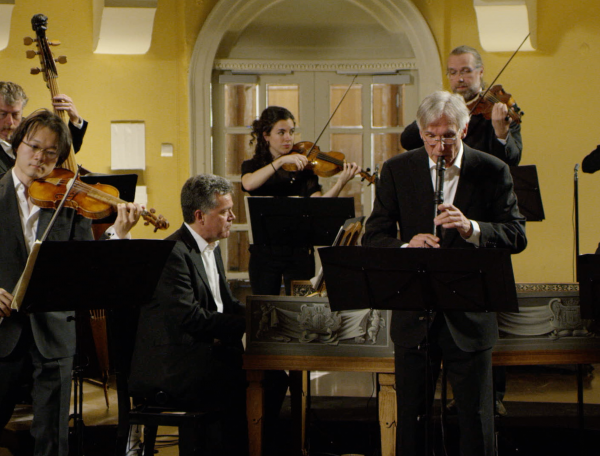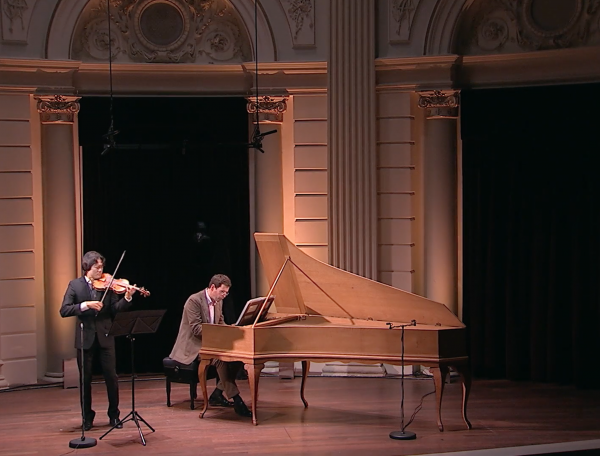

'Brandenburg' Concerto No. 3 in G major
BWV 1048 performed by the Netherlands Bach Society
conducted by Shunske Sato
Muziekgebouw aan 't IJ, Amsterdam
Behind the music
Surprising
Bach chooses an unusual form and instrumentation
This concerto is remarkable for its unusual form and instrumentation. Bach composed it for three violins, three violas, three cellos and basso continuo. In other words, 3x3, which is a rational choice you would expect from a modernist like Pierre Boulez, rather than a Baroque composer like Bach. There is no distinction between solo and ensemble instruments: all the strings play both solo and tutti.
The question is whether Bach originally planned the instrumentation like this. In the final movement, the cellos have no individual role and correspond harmoniously with the continuo. In the first movement, too, they form the least divided group. This may indicate that the concerto was based on a version with just one cello part.
The striking thing about the form is the lack of a fully-developed slow middle movement. The two fast movements are separated by an adagio of a single measure consisting merely of two sustained chords: a harmonic cadence that seems to have been composed more as a bridge and short pause for breath. In this performance, Shunske Sato decided to make the middle movement into a real pause for breath and play a brief cadenza.
Both the fast movements are characterised by a strong rhythmic drive. The first movement is dominated by a galloping rhythm and the latter by fast notes streaming through the instrument groups like a perpetuum mobile. When Bach reused the first movement as the opening sinfonia of the Whitsun cantata Ich liebe den Höchsten von ganzem Gemüte, BWV 174, he added two oboes, an alto oboe (‘taille’) and horns to the strings, and a bassoon to the continuo.
Brandenburg concertos, BWV 1046-1051
In March 1721, Bach sent a manuscript from Köthen to Berlin entitled ‘Six concertos with several instruments’ (Six concerts avec plusieurs instruments), dedicated to Christian Ludwig (1677-1734), Margrave of Brandenburg-Schwedt. In the preface, Bach stated that he had played for the margrave ‘a couple of years ago’ and had promised to send him ‘some of his compositions’. That was probably during a visit to Berlin in March 1719, when Bach had travelled to the Prussian capital to take receipt of a new harpsichord for the court in Köthen. The music that he sent to the margrave a couple of years later (which subsequently became known as the 'Brandenburg' Concertos) was Bach’s ultimate view of the most important large-scale instrumental genre of his day: the concerto.
A concerto nearly always involves a solo instrument (or combination of solo instruments) and an ensemble. The key idea is the alternation between one or more soloists and the whole ensemble, in a sort of light-hearted competition. In the six 'Brandenburg' Concertos, Bach explores every facet of this genre, with regard to both instrumentation and the way in which he handles the form. All the traditionally used string and wind instruments and the harpsichord appear as soloists, the musical forms range from court dances to near-fugues, and the relationship between the solos and tutti instruments is always shifting. Together, the six concertos thus form a virtuoso sample sheet of the Baroque concerto.
- BWV
- 1048
- Title
- Concerto in G major
- Epithet
- 'Brandenburg' Concerto No. 3
- Instrument
- viola, violin
- Genre
- orchestral works
- Serie
- Brandenburg concertos
- Year
- 1719-1720
- City
- Köthen
- Occasion
- Dedicated in 1721 to Margrave Christian Ludwig of Brandenburg
- Special notes
- Bach used the first movement in 1729 as a sinfonia in the cantata Ich liebe den Höchsten von ganzem Gemüte, BWV 174.
Extra videos
Vocal texts
Original
Translation
Credits
-
- Release date
- 1 September 2017
-
- Recording date
- 7 October 2016
-
- Location
- Muziekgebouw aan 't IJ, Amsterdam
-
- Violin and direction
- Shunske Sato
-
- Violin
- Paulien Kostense, Emily Deans
-
- Viola
- Pieter Affourtit, Anneke van Haaften, Jan Willem Vis
-
- Cello
- Lucia Swarts, Barbara Kernig, Shuhei Takezawa
-
- Double bass
- Hen Goldsobel
-
- Harpsichord
- Siebe Henstra
-
- Director
- Lucas van Woerkum
-
- Assistant director
- Stijn Berkhouwer
-
- Music recording
- Guido Tichelman, Bastiaan Kuijt, Misha de Kanter
-
- Music edit and mix
- Guido Tichelman
-
- Camera
- Bart ten Harkel, Thijs Struick, Martin Struijf
-
- Intern camera
- Klazina Westra
-
- Lights
- Zen Bloot
-
- Set technique
- Justin Mutsaers
-
- Data handling
- Jesper Blok
-
- Project manager nep
- Peter Ribbens
-
- Interview
- Onno van Ameijde, Marloes Biermans
-
- Producer concert
- Marco Meijdam
-
- Producer film
- Jessie Verbrugh
Discover
Help us to complete All of Bach
There are still many recordings to be made before the whole of Bach’s oeuvre is online. And we can’t complete the task without the financial support of our patrons. Please help us to complete the musical heritage of Bach, by supporting us with a donation!

